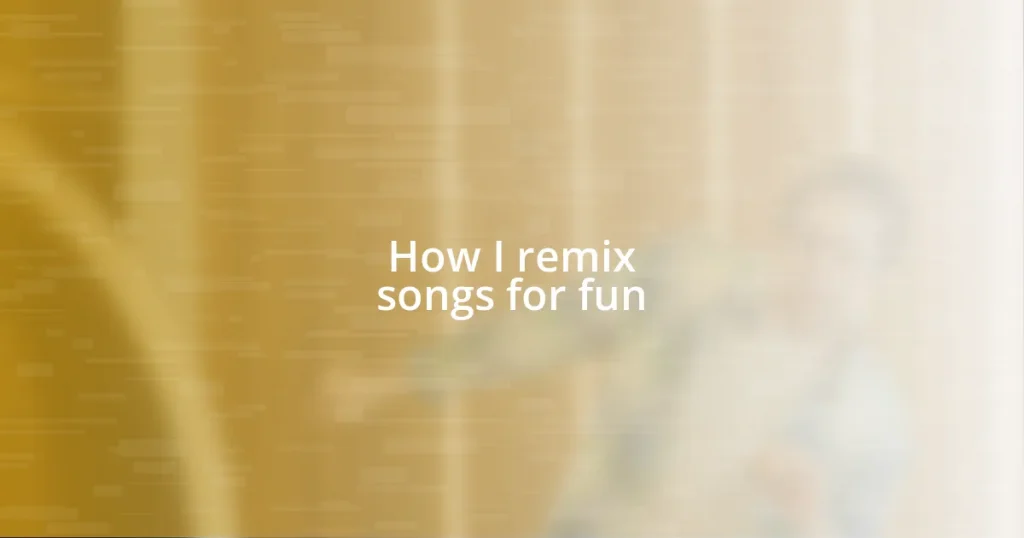Key takeaways:
- Authentic band merchandise features quality materials, unique designs, and official tags that reflect the band’s identity and maintain value over time.
- Identifying reputable sellers involves checking for positive reviews, transparency in product information, and engagement with the music community through social media.
- Diligent research on merchandise history and price comparisons can help avoid counterfeit items, ensuring purchases support the artists and carry personal significance.
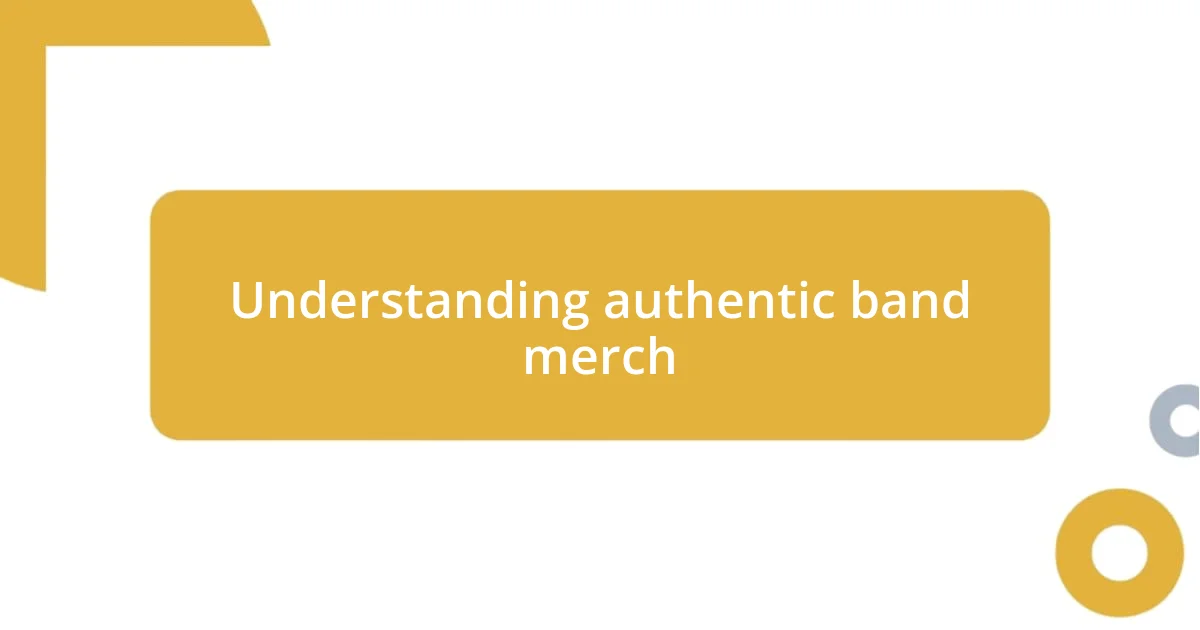
Understanding authentic band merch
Authentic band merchandise has a way of capturing the spirit of the music while connecting fans with their favorite artists. I remember the thrill of unboxing a rare vinyl shirt from my favorite band; that moment felt like an extension of my fandom. Real merch often carries unique designs or limited-run prints that reflect the band’s identity—it’s not just clothing, but a badge of loyalty.
When I rummage through my concert tees, I notice how each one tells a story. The fabric, the printing method, and even the tag can offer clues about authenticity. For instance, high-quality textiles and specific printing techniques, like discharge printing, tend to indicate genuine merchandise, while cheaper materials usually suggest otherwise. Have you ever wondered why knowing the differences matters? Authentic items often maintain their value over time, becoming treasures rather than just another shirt in the closet.
Moreover, understanding where the merch is sold plays a crucial role in determining authenticity. Buying directly from a band’s website or a reputable retailer means you’re likely to get what you pay for. On the flip side, I’ve had some eye-opening experiences at flea markets, where impulse buys led me to questionable quality. These moments taught me to research before making a purchase—sometimes even identifying a trusted seller just by a simple internet search can make all the difference.
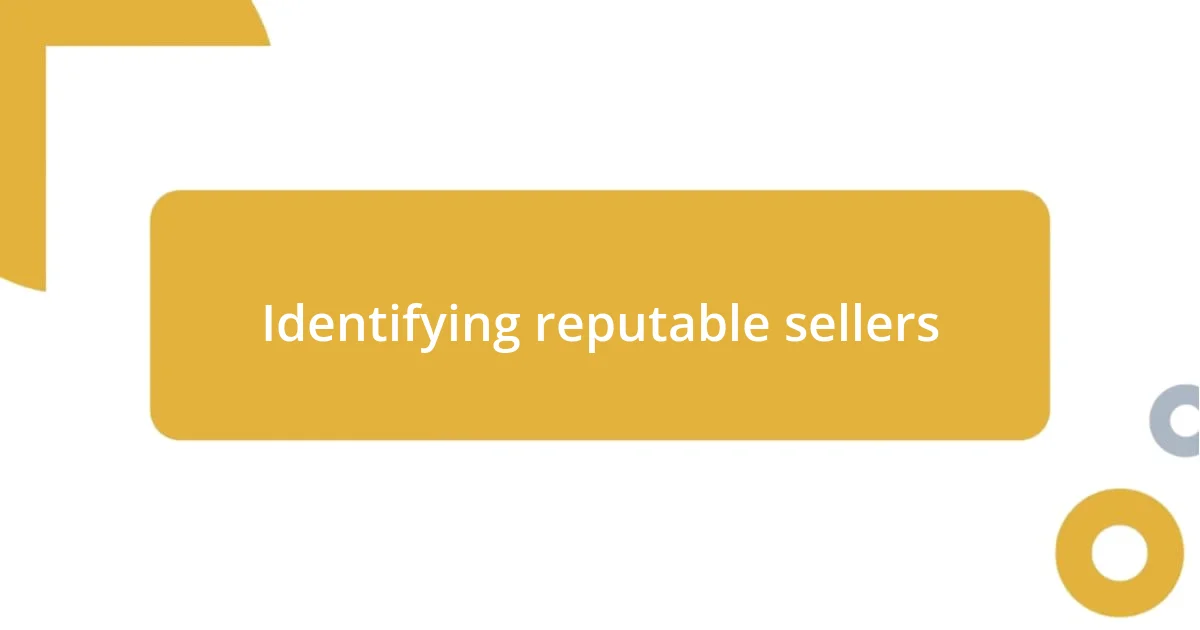
Identifying reputable sellers
When it comes to identifying reputable sellers, I find it essential to look for established online platforms with positive reviews. I once stumbled upon a seller with a slick website and tempting prices, which turned out to be a costly mistake. Learning from that experience, I now prioritize vendors with solid customer feedback, which often provides insights into both merchandise quality and shipping reliability.
Another crucial factor is transparency. Genuine sellers typically provide clear information about their products, such as detailed descriptions, size charts, and high-resolution images. I recall purchasing a limited edition hoodie that had only a small, blurry picture. After the lackluster delivery, I learned the hard way that if I can’t see the product clearly, it’s best to steer clear of that seller.
Lastly, I encourage fans to engage with the community. Authentic sellers often have a presence on social media platforms where they interact with fans. I recall a time when I reached out to a seller about a specific merch item and they responded promptly, sparking a short yet enjoyable conversation about my favorite tracks. This connection deepened my trust and reinforced that I was making a purchase from someone who genuinely cared about the music and its fans.
| Factor | Details |
|---|---|
| Reviews | Look for positive customer feedback and established platforms. |
| Transparency | Find sellers who provide detailed descriptions and high-quality images. |
| Community Engagement | Consider sellers who interact with fans on social media. |

Analyzing product quality
When I analyze product quality in band merch, I pay close attention to the stitching and overall construction. A few years ago, I bought a vintage band tee that instantly became my favorite. However, I soon noticed uneven stitching and some fraying at the seams. It broke my heart to see that wear and tear creeping in so quickly, a stark contrast to my other pieces that have stood the test of time. Authentic items often showcase meticulous attention to detail, which can be a strong indicator of their quality.
To evaluate product quality effectively, consider the following factors:
-
Fabric Type: Natural fibers like cotton and blends typically signal better quality than synthetic ones.
-
Print and Design: High-quality screen printing or embroidery will be vibrant and well-defined.
-
Weight and Feel: Thicker fabrics often indicate durable, more authentic products.
-
Labels and Tags: Genuine merch usually features proper branding labels, indicating it’s been produced by the authorized vendor.
In my experience, the feel of the merchandise often speaks volumes about its authenticity. For example, I was once fortunate enough to snag an official tour hoodie at a concert. The moment I slipped it on, I knew it was special—the softness of the fabric enveloped me in a way that cheap imitations never could. That hoodie was more than just clothing; it carried memories of my favorite live performance and camaraderie with fellow fans.
When evaluating the quality of merch, I focus on these aspects:
-
Texture: Authentic items feel substantial, while knockoffs often feel flimsy.
-
Durability: Check for how well the merch holds up under everyday wear; real band tees often last for years.
-
Scent: Surprisingly, a faint new fabric smell can indicate quality manufacturing, while a harsh chemical scent often points to lower-grade materials.
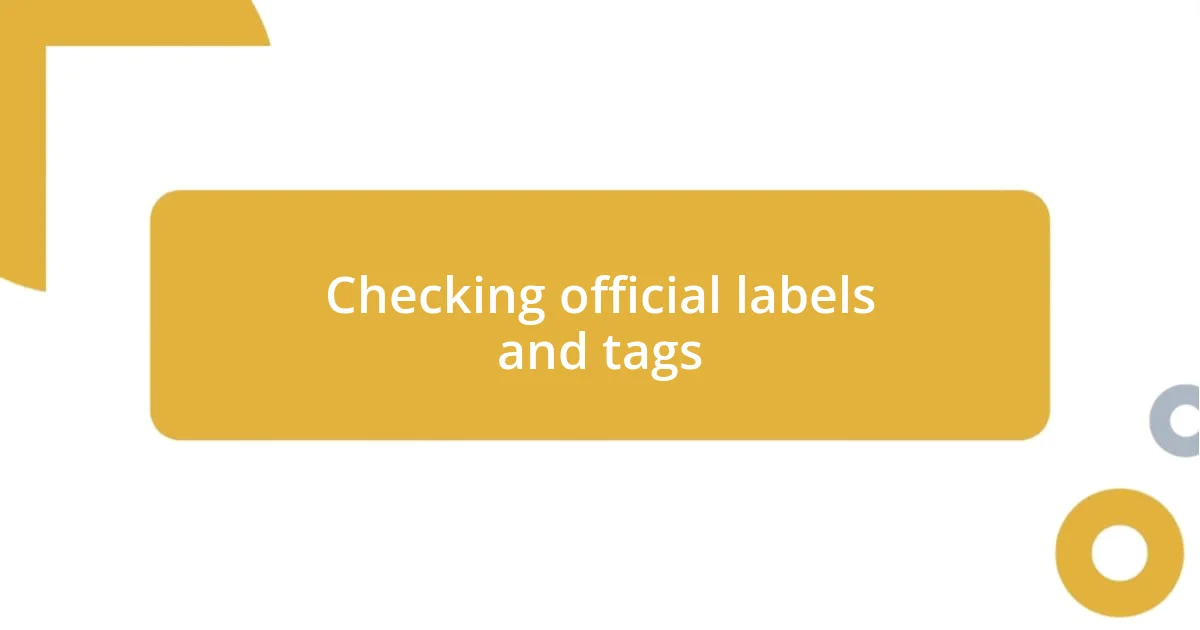
Checking official labels and tags
Checking the labels and tags on band merch is a crucial step in ensuring its authenticity. I remember purchasing a hoodie at a local music festival, and while it was comfortable, I made a point to check the tag inside. It showcased the band’s logo along with a label indicating it was officially licensed merchandise. This small detail gave me peace of mind, knowing that my purchase directly supported the artists I loved.
Have you ever taken a moment to scrutinize the tags on your favorite band t-shirts? Authentic items typically carry detailed labels that not only provide sizing information but also indicate the manufacturer and place of origin. For example, I once snagged a vintage band shirt from a thrift store. It had a faded tag that led me to discover it was sourced from an iconic tour. That tag added to the shirt’s value and made me appreciate it even more, fostering a deeper connection to the music and the moment.
Engaging with labels can reveal more than just authenticity; it often uncovers the story behind the merchandise. I once felt a sense of pride while examining a tag that listed ethical production practices. Knowing that my favorite band supported fair labor inspired me to not only cherish the item but also share the story with fellow fans. These discoveries transform a simple piece of clothing into a cherished artifact of shared experiences and communal love for music.

Recognizing unique design features
Recognizing unique design features in band merch can truly elevate your shopping experience. I still remember the thrill of spotting a shirt featuring an intricate graphic that seemed to capture the band’s essence perfectly. The design wasn’t just a logo; it was an artistic expression that told a story. Such unique elements, like custom illustrations or limited-edition prints, often signal that you’ve found something authentic and special.
Have you ever noticed how the colors in authentic band merch have a depth that stands out? I once came across a beautifully designed tour poster that was printed using a process called silkscreening. The vibrancy of the colors and the texture of the print made it feel like a piece of art rather than just merchandise. Designs that are overused or poorly reproduced often lose that level of detail, transforming them into generic items that lack personal significance. Authentic pieces connect you to the music on a deeper level.
Pay attention to small intricacies like the placement of graphics or custom tags. I remember a time when I purchased a beanie emblazoned with an unusual design placed at an angle that made it uniquely appealing. It wasn’t just another beanie; it became a conversation starter, reminding me of unforgettable concert moments. Unique design features speak to me as assurance that my purchase is a genuine piece of the band’s journey, something that can’t be replicated. Isn’t that more fulfilling than settling for something that lacks originality?
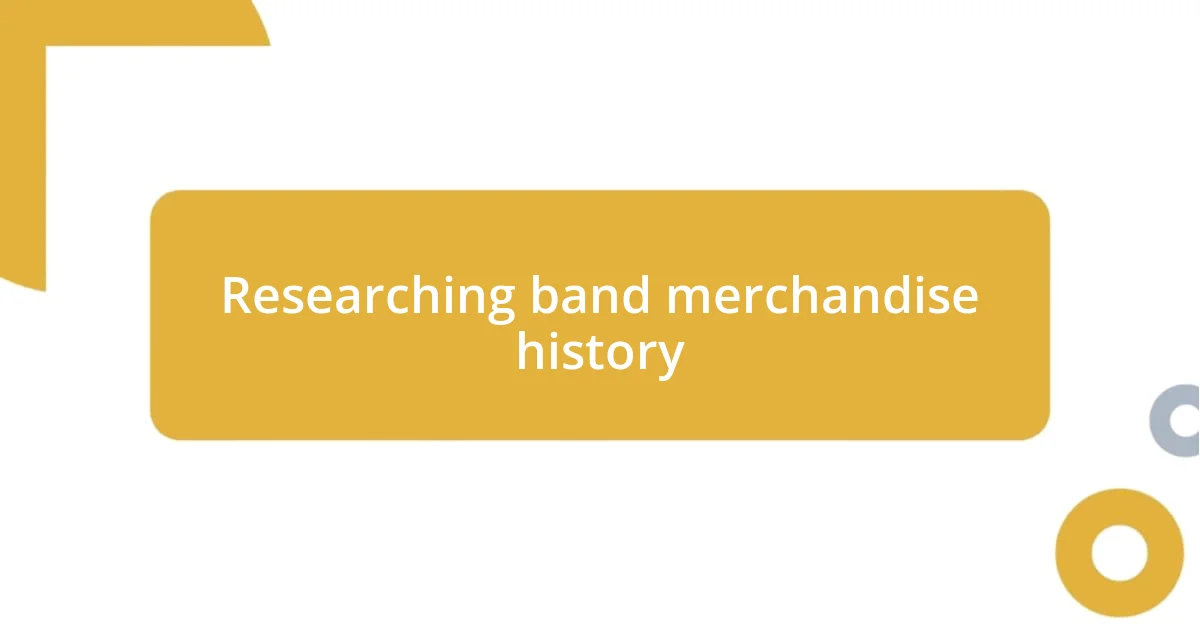
Researching band merchandise history
Researching the history of band merchandise can profoundly enhance your appreciation for what you’re buying. I remember diving into the archives of a band I loved, only to uncover how their merch evolved from simple t-shirts to intricate designs that reflected their album themes. It felt like unearthing hidden treasures; every piece of merch had its own story that connected me deeper to the band’s journey.
When I thought about why certain designs became icons, I found that many early band merchandise items were handmade at local shops, making them feel so unique. For instance, I discovered that a shirt I had worn at countless concerts was inspired by a mixtape cover from back in the band’s early days. The excitement of knowing this history brought an entirely new level of nostalgia each time I wore it; it felt like I was wearing a piece of music history.
Engaging with the origins of band merch can also spark curiosity about the impact of tours and album releases. I often reflect on how the limited edition items I collected during a band’s tour were linked to specific moments in my life. It’s remarkable how a simple hoodie or a vinyl can remind me of unforgettable nights and friendships forged over a shared love for music. Isn’t it fascinating how the history behind these items makes them more than just fabric or plastic? They become vessels for memories and connections.
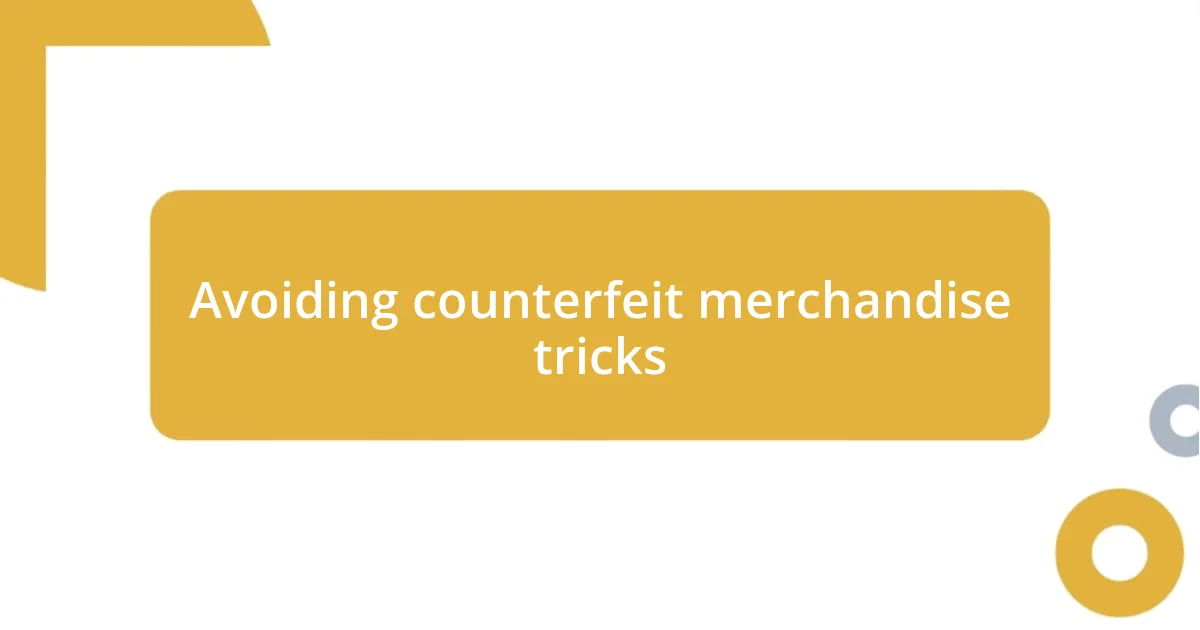
Avoiding counterfeit merchandise tricks
When it comes to avoiding counterfeit merchandise tricks, I’ve learned that diligent research goes a long way. I recall a time I almost bought what I thought was an epic band hoodie at a convention, only to find out later that the stitching was subpar and the label looked completely off. A little bit of digging revealed that the band had a specific logo placement and thread count on their legit merchandise, making it easy to differentiate between authentic and fake.
Sometimes, it helps to compare prices before making a purchase. When I debated buying a rare vinyl album, I noticed the price was suspiciously lower than what I’d seen at official retailers. After chatting with other fans at a local music shop, I found out that the lower price usually indicates a knockoff. I realized that the old adage “if it seems too good to be true, it probably is” couldn’t be more applicable in this scenario.
Another crucial tip is to verify the seller. I remember being excited about an online option that claimed to have exclusive merch, but their lack of social media presence and reviews made me hesitate. Trusting established platforms not only gave me peace of mind but also led me to unique pieces I hadn’t found elsewhere. Authenticity often lies in the source, and nothing beats the thrill of buying directly from the band’s official site or reputable vendors. Have you ever confronted a choice like this? It’s those little decisions that lead to truly valuable collectibles rather than disappointing duplicates.














